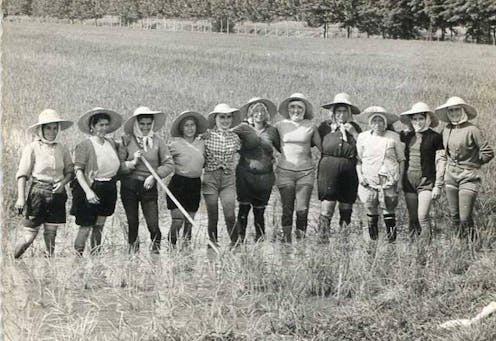In an era before the dawn of pesticides and mechanisation, an all-female workforce was employed to “disinfect” and harvest Italy’s rice crops. These Italian rice weeders may be a thing of the past, but they have a remarkable political legacy.
Italy was, and remains, Europe’s largest rice producer. The rice weeders, known in Italian as “mondine”, could be found knee-deep in flooded fields from May until July, across Italy’s “rice belt” which spans the northern regions of Piedmont, Emilia Romagna, Lombardy and the Veneto. In my ongoing research, I study oral histories of rice weeders who worked between 1940 and 1965, collected from several interview projects and documentaries.
Idyllic though the glassy mirrors of the flooded rice fields may seem now, the paddies often resounded with the sound of weeders’ protest songs. To avoid punishment for talking during working hours, weeders developed an incredible repertoire of polyphonic call-and-response songs, often lamenting miserable working conditions or exploitative employers.
As one Italian senator put it in 1953, the labour of rice weeders deserved its own circle of hell in Dante’s inferno. Apart from eight-hour days under the beating sun, rice weeders were tormented by malaria-carrying mosquitoes and malnourishment, and suffered much higher miscarriage rates than other women workers.
When the actress Silvana Mangano was shown how to imitate the rice weeders’ labour for her role in cult left-wing film Bitter Rice in 1949, she reportedly said: “Like this, for eight hours? I wouldn’t do this work even for a million a day!” A number of the women in the interviews I’m studying met with Mangano in 1948 as extras on the set of the movie.
Knee-deep in protest
It is perhaps because of these exploitative conditions that collective and political activism thrived in the rice fields. From the 1900s, rice weeders joined up in their droves to left-wing organisations such as the Italian communist and socialist parties, but also to the Unione donne italiane (the Italian Women’s Union) and working class institutions such as the Case del popolo (People’s Houses) and cooperatives.
Under Italian fascism, between 1922 and 1943, other left-wing groups were forced underground. But the rice weeders won important concessions from the fascist government through strikes and protest. These concessions included paid travel, and improved provisions for food and shelter.
During the Nazi occupation of Italy, many rice weeders deserted the rice fields, and in 1944 refused to work for their oppressors. Some did not return to work until the fall of fascism.
The rice weeders were also active in Italy’s liberation from the Nazis. Many interviewees were part of the Italian Resistance. Some recalled hiding partisans in their homes, or acting as couriers between battalions.
Tragically, as with women’s wider participation in the liberation of Italy from the Nazis and fascists, the weeders’ contributions to the war have often gone unrecognised. One interviewee who was a rice weeder and member of the resistance recalled how after the war her husband was given an award for his role as a partisan. When she too was offered an award, her husband intervened, saying “one in the house is enough”.
Sisters of Togliatti
The weeders also protested against their replacement by agricultural machinery. One rice weeder who worked in Filo, Bologna during World War II, recounted in an interview:
We went up against the combine harvesters, together on the land … and we stopped them. My husband told me ‘One of these days they won’t stop’. I replied, ‘I would happily die for my work’.
The weeders’ role was definitively replaced by pesticides and mechanisation in the 1960s.
In the interviews I’m studying, the women made frequent references to left-wing figures, such as Italian communist leader Palmiro Togliatti, who they sung about as a “workers’ champion”. Others declared themselves to be the “sisters of Togliatti”. One woman, who lived in Medicina, recounted:
We felt that the fight for liberation was, yes, a fight against the Germans and the fascists, but also a great source of hope for us peasants, who were so exploited and poor.
Heroines and martyrs
Today, Italy’s rice weeders have gained a cult following for their songs and their dress. Choirs now perform the weeders’ songs at festivals in Italy and abroad, sometimes in incongruous collaborations with young rock bands.
The success of the film Bitter Rice catapulted the weeders into the public consciousness because of how they dressed. Previously, the weeders had worn long skirts in the fields, but in the film Mangano wore shorts and ripped stockings. The weeders subsequently adopted this style, and it became their most remembered – and reproduced – characteristic.
The weeders are also remembered for the assassination of Maria Margotti, who was shot by a member of the police during an agricultural protest in May 1949. Her death was used by the Italian left as evidence of the state’s repression and abuse of the working classes. Elements of the Italian communist party used Margotti’s death to encourage popular resistance to the Christian Democrat government.
Because of the weeders’ reputation for left-wing support, it was convenient for the Italian left to portray Margotti as a weeder. However, my ongoing research shows that Margotti was not, in fact, a contracted rice weeder, but worked at the local brickyard. After Margotti’s death, the ANPI, the National Association of Italian Partisans for ex-resistance members, offered to care for her children. Her daughters subsequently received intense media exposure, and she continues to be used as a martyr for left-wing causes.
The rice weeders’ activism and agitation was remarkable. Yet, my research has revealed that over time their memory has been in turn silenced, sexualised, or – as Margotti’s case shows – used for political ends.


